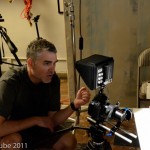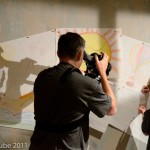The above video was part of the presentation during the Nikon D800 introduction in Bangkok. A short portion of it (at the 0:18 mark) was taken from the time-lapse the “The Mountain” (see the 2:10 mark) which was shot with a Canon 5D MarkII by Terje Sorgjerd. Oops. Here are some videos shot with “real” Nikon cameras.
The above video was shot with a Nikon D700… yes D700:
More than one year ago, Nikon didn’t have any good solution for full HD video, but I really wanted to use all the great lenses to shoot a music video, so I “forced” this video out of D700, creating more than 3000 single pictures that were lit with SB 800 and 900 other sources for light painting and later edited into moving pictures. Lens used were, 12-24, 24-70, and 50mm 1.4 and … so a pure Nikon D700 video job 🙂
Next video “Compressed 03” was shot with a Nikon D90 by Kim Pimmel:
Compressed 03 continues my interest in telling stories through analog visual effects – everything in the film was made with physical materials and tools in my studio. By using frame by frame stop motion and time lapse techniques, fluid dynamics and magnetism are transformed into majestic explosions and seething storms.
Sounds best on headphones, and looks best fullscreen!
Shot with Nikon D90, macro lens & custom built timer / trigger
Edited in Adobe Premiere
Scored in Ableton LiveI find analog things appealing – whether it’s vinyl or photographic film, there’s a certain richness and magic that’s difficult to replicate with digital means. The Compressed series showcases analog visual effect techniques, so everything in the films is made by hand, with physical materials and tools in my studio. For each of the Compressed films I try to develop and master a set of analog techniques with which I can craft a narrative.
For the effects in Compressed 03, I was drawn to the dynamic interactions between liquids. I spent about a month playing mad scientist to see what gave the most interesting results. I raided the kitchen for common stuff like milk, oil, and molasses. I stopped at the drug store and buy random things such as witch hazel, nail polish, and bubble blowing mix. I ordered exotic stuff like ferrofluid online. Some liquids repelled each other, some caused coagulation, and some created intricate patterns.
I settled on ferrofluid as my primary liquid, since it yielded some nice interactions with other liquids and could be manipulated using magnetism. All of the black or brown seen in the film is ferrofluid – needless to say it was a very messy few months!
The whole film is shot with a Nikon D90 DSLR, frame by frame, and animated using stop motion and time lapse techniques. This allowed me to control the effects by manipulating various parameters by hand – for example I could blow air onto the scene with a straw to adjust flow direction, or add liquid outside the shot to accelerate an effect. I also hacked a flatbed scanner so I could control it from my computer – and by physically connecting the scanner carriage to other equipment I could adjust parameters of the scene very precisely.
To control the camera for the frame by frame animation, I used a custom timer that I had built for a previous project.
Except for the opening title sequence, everything was shot with a macro lens. While the scale of the scenes in the film may seem grand, they actually range from the size of a post-it, to the size of a playing card. To work at that small scale I used syringes to dispense minuscule amounts of liquids, as well as a whole assortment of tiny magnets to control the ferrofluid. As anyone who has worked with macro can tell you, it’s a pain to work with, but it opened up a whole world of visual opportunities for the project.
Once shooting was wrapped, I edited the film with Premiere, while concurrently writing the soundtrack in Ableton Live.
Since I’m kept pretty busy during the day designing software for Adobe, the film was made during my evenings and weekends over the span of about 4 months.
The next two videos were shot by Bruce Brown with a Nikon D7000:
In developing the projects “Fly” music video and “A” student video I needed a way to shoot motion images of high quality, with a lightweight and cost effective tool. I have used digital Nikon Cameras for years as a professional photographer (http://www.BruceBrown.com), but never thought about using them for motion/video. In the past I had used Arriflex Super 16mm cameras with film stock for motion projects – this was time consuming and expensive. I had chosen film mainly because I felt the quality was superior to digital. That changed when I did a video test shoot on the Nikon D7000. The quality was amazing. The 1080P files from the Nikon are excellent video files when converted from H264 into the editing format of ProRes 422. The images are robust and more then adequate for color grading. I was convinced it is the perfect tool for these projects.
In “Fly” the D7000 was used both for the live action/performance parts of the music video as well as the time-lapse shots. The time-lapse was incorporated into the live action with the use of a green screen. Editing with Final Cut Pro X I utilized chroma key to composite the clouds and rain into the window for dramatic effect. One of the best things about using the Nikon D7000 was the lens choice. I was able to use any lens from my kit: Lensbaby control freak, manual focus AIS, AFS Nikkor zooms, primes and macro lens. Utilizing theses tool enabled me to capture images needed to illustrate the point of view of the story.
Having less then a day of access to a classroom location for the “A” student video, speed and ease of set up was essential. The video was completed in a 5 hour session with 38 different scenes and 200 takes not to mention the cooperation of the two dozen 5th grade students. The D7000 gave me the flexibility to move the camera rapidly and effectively; shooting from a ground level position for a dolly move on a Konova K3 slider in one take, and then jumping up on a 8 ft. ladder for an overhead jib move in the next scene. Ease of mobility was the key to the success of this video. Having this versatility and agility of use was incredible.
I am a big fan of this new DSLR technology I can’t imagine going back to the old production ways.
More info about Bruce Brown:
http://www.BruceBrown.com/
http://brucebrownphotography.tumblr.com/
https://www.facebook.com/BruceBrownPhoto
https://twitter.com/ – !/BruceBrownPhoto






